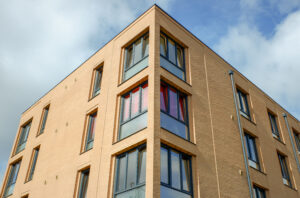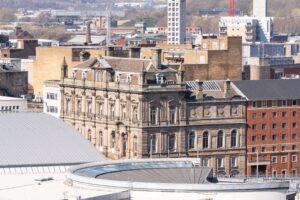Experts found narrow streets in city centres, hemmed in by tall buildings, may be acting as traps for pollution and contributing to poor air quality.
A study by Nottingham Trent University (NTU) found that streets narrower than 20 metres experience irregular and sometimes dangerously high spikes in particulate matter.
The team carried out a walking survey in London – from Finsbury Square to Undershaft Street – monitoring levels of PM10 and PM2.5 as they went.
The highest pollution spikes were recorded in narrow corridors such as Wilson Street and Eldon Street, where PM10 levels exceeded WHO’s recommended daily thresholds. The tall buildings surrounding these areas were found to inhibit air circulation, creating “urban canyons” where emissions build up instead of dispersing.
In contrast, wider roads like Bishopsgate and Camomile Street showed more stable and significantly lower levels of pollution, aided by better airflow and smoother traffic movement.
The findings, presented at the Nordic Energy Informatics Academy Conference in Sweden, also revealed that streets aligned at a 45-degree angle to the prevailing wind were especially prone to poor ventilation, further compounding the problem.
Professor Amin Al-Habaibeh, who led the study, said: ‘London’s iconic streets may be beautiful, but invisible smog traps which prevent pollution from dispersing may be silently harming public health.
‘Our findings show a clear link between narrow roads, tall buildings, and air quality spikes—especially for pedestrians and cyclists who are the most exposed.’
The team acknowledge that while initiatives such as the Ultra Low Emission Zone and Congestion Charge have improved conditions, more targeted interventions are needed.
They suggest solutions including the installation of vertical green walls and tree planting to capture particulates, the use of AI-driven traffic management to reduce idling and the creation of green mobility corridors to promote walking, cycling and micro-mobility.
They also call for stricter controls on wood-burning stoves and non-electric vehicles in the most vulnerable areas.
PhD researcher Nikhil Ravindra, of NTU’s School of Architecture, Design and the Built Environment added: ‘There’s a temptation to think of ULEZ and electric vehicles as silver bullets, but our data show that volume of traffic, road layout, building height and wind direction all play a role in air quality. A greener and smarter approach is urgently needed.
‘The value of artificial intelligence also has a part to play in managing electric vehicle charging and traffic flow, as AI-enabled systems could reduce carbon emissions by up to 40 per cent annually per vehicle.’
Photo by Sean Pollock via UnSplash
In related news:

















Leave a Reply